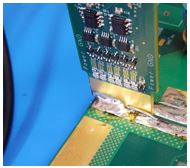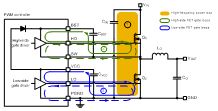 |
|
IN THIS ISSUE:
» Optimizing Regulator Output Capacitance (Part 2): Using Load Slammers
» Dynamic Torque Measurements Reveal True Electric Machine Characteristics
» The Engineer’s Guide To EMI In DC-DC Converters (Part 6): Mitigation Techniques Using Discrete FET Designs
» Focus On Magnetics:
Optimizing Transformer Winding Design For Max Efficiency Over Output Current Range
» Spotlight On Safety & Compliance:
Isolation Standards Say Little About Isolator Performance
» New Power Products
» Other Top Power News
From the Editor's Desk David G. Morrison
Editor, HOW2POWER TODAY

Designers have multiple reasons for optimizing the transient response of their on-board power converters and voltage regulators. But lately cost, which is always an issue, has come to the fore as key players in the supply chain have driven up the price of capacitors, particularly conductive polymer aluminum solid electrolytic capacitors and high-value multilayer ceramic caps, which find use in voltage regulator circuits. As David Baretich, observed in part 1 of his article on “Optimizing Regulator Output Capacitance,” the rising component cost is making it less feasible for designers to deploy large amounts of capacitance for power supply bulk decoupling. Consequently, there’s a greater need than ever to verify and optimize regulator transient response through testing. Baretich’s part 2 article in this issue describes how load slammers can be used to optimize a regulator design with the goal of capacitance reduction in mind. Testing dynamic performance is also at the heart of Mitch Marks’ article on dynamic torque measurement for electric machines. Like the load slammer feature, this piece highlights the capabilities of a test instrument. In this case, it’s a power analyzer in combination with a high bandwidth torque sensor, which are used to observe a motor’s dynamic performance. Other articles here include Tim Hegarty’s latest on EMI in dc-dc converters—this one addresses converters using PWM controllers and external MOSFETs, Dennis Feucht’s article on optimizing transformer efficiency when the load current varies over a range, and a Safety & Compliance column dispelling misconceptions about isolation standards. All this and more in the September issue of How2Power Today.
|
|
 |
 |

|
HOW2POWER EXCLUSIVE DESIGN ARTICLES 
|
Optimizing Regulator Output Capacitance (Part 2): Using Load Slammers
by David Baretich, ProGrAnalog, Portland, Oreg.
The first part in this series introduced the topic of load slammers, explained what characteristics should be considered when selecting them and compared some of the available options for transient load testing of voltage regulators. This second part continues by discussing how to use load slammers effectively to design, evaluate, debug, and validate your on-board power source.
Read the full story…
|

Designers must consider several issues when using load slammers, including where to place the slammer; where and how to measure output voltage and current; and where to start in the testing process. |

|

Torque measurement during
a control change from PWM
to six-step modulation. |
Dynamic Torque Measurements Reveal True Electric Machine Characteristics
by Mitch Marks, HBM Test And Measurement, Madison, Wisc.
Mechanical power measurements of an electric machine are very important to help understand what the motor is doing at any given time and operating point. Mechanical measurements help characterize the motor, build up models for the machine, ensure confidence in controllers and understand the limits of the system. Torque accuracy and bandwidth are particularly important for designing a controller and implementing an electric motor solution. Since torque is not a static value, it is preferred to have a highly accurate averaged measurement. A high-bandwidth torque measurement is also needed to understand what happens instantaneously. This could be cogging torque for a steady-state operation, torque response during loading and even torque during control changes. This article demonstrates the capabilities of using a highly accurate and high bandwidth torque sensor, such as the T12HP, in combination with the eDrive power analyzer, to make various types of high-bandwidth torque measurements. Read the full story…
|

The Engineer’s Guide To EMI In DC-DC Converters (Part 6): Mitigation Techniques Using Discrete FET Designs
by Timothy Hegarty, Texas Instruments, Phoenix, Ariz
Parts 1 through 5 of this article series offer practical guidelines and examples to mitigate conducted and radiated electromagnetic interference (EMI), specifically for dc-dc converter solutions with monolithically integrated power MOSFETs. As a sequel to those earlier parts, this article explores EMI abatement in dc-dc regulator circuits that employ a controller driving a discrete pair of high- and low-side power MOSFETs. This article provides guidelines for laying out a multilayer PCB of a half-bridge design with MOSFETs and controller to achieve excellent EMI performance. The imperative is to minimize critical loop parasitic inductances by careful power-stage component selection and PCB layout. A layout example demonstrates that it’s possible to reduce the generation of conducted electromagnetic emissions without sacrificing efficiency or thermal performance metrics.
Read the full story…
|

The high-frequency current loops
critical to EMI for a synchronous
buck regulator. Minimizing the area
of the power loop is essential.
|

 |  |

FOCUS ON MAGNETICS 
Sponsored by Payton Planar Magnetics
A monthly column presenting information on power magnetics design, products, or related technology |

Optimizing Transformer Winding Design For Max Efficiency Over Output Current Range
by Dennis Feucht, Innovatia Laboratories, Cayo, Belize
In previous articles on interwinding power transfer in transformers and coupled inductors, design formulas were derived for maximum power transfer having peak winding transfer efficiency, ηmax, using the transfer voltage ratio, υp and the ratio of winding to effective core resistance, βp. In this article, some extended development of power-transfer theory applies the additional constraint of holding the secondary current (i.e. the load current) constant as βp is varied. The migration of the operating-point (op-pt) at ηmax on one efficiency curve to another η curve at a different βp under constant output current shows that as winding resistance is varied in design, the η op-pt can move to either side of the new ηmax. As current is varied, the op-pt on a given η curve also moves and efficiency changes. A slight variation in current for op-pts to the right of ηmax causes a large change in η, especially with low winding resistance (or βp). This article analyzes and derives the theoretical optimal peak efficiency for a power converter when its load (and that of its transformer) spans a range and uses that information to design the transformer. Read the full story…
|

 |
 |

SPOTLIGHT ON SAFETY & COMPLIANCE 
Sponsored by Power Integrations
A monthly column discussing standards and regulatory requirements affecting power electronics |

Isolation Standards Say Little About Isolator Performance
By Kevin Parmenter, Chair, and James Spangler, Co-chair, PSMA Safety and Compliance Committee
There is confusion concerning which standards apply to the various types of optocouplers, optodrivers, and isolators used in gate drive and power supply circuits. How do these electronic devices meet safety rules and what are some of the differences between the requirements imposed by the different safety and regulatory agencies? There is also a general misconception that isolation standards set requirements for isolator performance beyond the input-to-output voltage isolation. And even though they are called out on isolator data sheets, they are not the main standards for most applications, but rather secondary standards that are referenced in other, application standards. In this article, the authors review the different isolator device types, identify some of the major isolation standards, and then discuss the requirements imposed on the different isolator device types. Read the full story…
|

 |
 |

 — POWER PRODUCTS IN 3 IMAGES OR LESS — POWER PRODUCTS IN 3 IMAGES OR LESS 
|

|

Infineon Technologies’ IRS2007S
200-V half-bridge gate-driver IC. |
Half-Bridge Gate Driver IC Enhances Reliable Start-Up Operation
 Photo: The 200-V half-bridge gate driver adds features such as undervoltage-lockout, deadtime and shoot-through protection, and low quiescent current, which translate to improved reliability and reduced system cost compared to previous-generation gate drivers. Photo: The 200-V half-bridge gate driver adds features such as undervoltage-lockout, deadtime and shoot-through protection, and low quiescent current, which translate to improved reliability and reduced system cost compared to previous-generation gate drivers.
More details… |


 |

|


Maxim Integrated Products’ MAX77714
and MAX77752 power-management ICs. |
PMICs Power Next-Generation Mobile Consumer Applications
 Diagram: The MAX77714 is a complete power-management IC (PMIC) for portable devices using system-on-chip applications processors. It features 13 regulators, 8 GPIOs, an RTC, and flexible power sequencing for multicore applications. Diagram: The MAX77714 is a complete power-management IC (PMIC) for portable devices using system-on-chip applications processors. It features 13 regulators, 8 GPIOs, an RTC, and flexible power sequencing for multicore applications.
 Diagram: The MAX77752 is a highly-integrated power management solution including three stepdown converters, an LDO, two external-regulator enable outputs, two dedicated load-switch controllers, and an inrush-current limiter, which can be configured as a third load-switch controller using OTP. Diagram: The MAX77752 is a highly-integrated power management solution including three stepdown converters, an LDO, two external-regulator enable outputs, two dedicated load-switch controllers, and an inrush-current limiter, which can be configured as a third load-switch controller using OTP.
See the full story…
|

Microchip Technology’s MCP39F511A
dual-mode power monitoring IC. |
Power Monitoring IC Measures AC And DC Power With High Accuracy
 Photo: The MCP39F511A is a flexible dual-mode power monitoring IC that measures both ac and dc modes with what the company describes as industry-leading accuracy of 0.1% error across a wide 4000:1 range. The chip addresses the growing need for more accurate power measurements in high-performance designs and is well suited for applications that use both modes to maintain safe operation, such as solar inverters, smart lighting and cloud servers. Photo: The MCP39F511A is a flexible dual-mode power monitoring IC that measures both ac and dc modes with what the company describes as industry-leading accuracy of 0.1% error across a wide 4000:1 range. The chip addresses the growing need for more accurate power measurements in high-performance designs and is well suited for applications that use both modes to maintain safe operation, such as solar inverters, smart lighting and cloud servers.
See the full story…
|



|
MORE POWER PRODUCTS:
• Scopes Deliver Faster Measurement Speed And Lower Noise
More details…
• Double Choke With Molding Technology Suits DC-DC Converters More details…
•
48-V Input Buck Regulators Offer BGA Option More details…
|

|






|



 |
 |

 |
 |


OTHER TOP POWER NEWS
|
|
 The Long Island Power Electronics Symposium, Trends In Power Electronics – 2018 will be held Thurs., November 8 in Hauppauge, NY. The Long Island Power Electronics Symposium, Trends In Power Electronics – 2018 will be held Thurs., November 8 in Hauppauge, NY.
 PowerAmerica has issued its 2018 Call for Projects, which seeks projects to accelerate the adoption of SiC and GaN wide bandgap power electronics technologies in the U.S. PowerAmerica has issued its 2018 Call for Projects, which seeks projects to accelerate the adoption of SiC and GaN wide bandgap power electronics technologies in the U.S.
 The Power Electronics Industry Collaborative (PEIC) will conduct its annual member meeting on Sept. 25 at ECCE 2018 in Portland, OR. ON Semiconductor’s Ali Husain will speak on key trends and challenges for the power electronics market. The Power Electronics Industry Collaborative (PEIC) will conduct its annual member meeting on Sept. 25 at ECCE 2018 in Portland, OR. ON Semiconductor’s Ali Husain will speak on key trends and challenges for the power electronics market.
 ARPA-E has announced a funding opportunity of up to $15 million for a new program called Building Reliable Electronics to Achieve Kilovolt Effective Ratings Safely (BREAKERS). Projects will develop designs for medium voltage, dc circuit breakers. ARPA-E has announced a funding opportunity of up to $15 million for a new program called Building Reliable Electronics to Achieve Kilovolt Effective Ratings Safely (BREAKERS). Projects will develop designs for medium voltage, dc circuit breakers.
 Milpower Source, a designer and manufacturer of MIL-Standard power conversion solutions, has announced its support of the “Gremlins” program, which is focused on enabling aerial launch and recovery of volleys of reusable unmanned air systems from existing military aircraft. Milpower Source, a designer and manufacturer of MIL-Standard power conversion solutions, has announced its support of the “Gremlins” program, which is focused on enabling aerial launch and recovery of volleys of reusable unmanned air systems from existing military aircraft.
|

|
